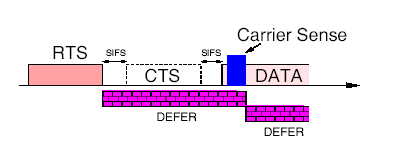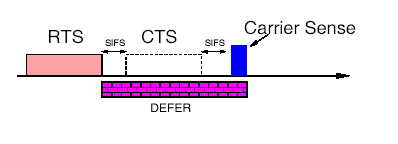The RTS/CTS mechanism was introduced to address the hidden node problem that the basic access method suffers from. The RTS/CTS mechanism is a combination of carrier sensing and and a modified version of the MACAW protocol.To understand how the RTS/CTS mechanism works, click here.
While the RTS/CTS mechanism resolves the deaf node problem, it introduces its own problems, which are more severe than the hidden node problem. This is the blocked node problem and was observed by Saikat Ray, Jeffrey Carruthers and David Staorobinski. A description of the blocked node problem can be found here.
This scheme solves the blocked node problem. Every node that receives a RTS inhibits itself from transmitting. If the node is false blocked, then data transmission does not take place while the node defers. It therefore follows that if a node assesses the channel to be idle during the during the expected data transmission period, it must be false blocked.
The RTS Validation scheme is based on this observation. A node that uses RTS Validation assesses the channel state during the data transmission phase, after it hears a RTS packet. If the channel is found idle, then it is false blocked and defers no longer, otherwise it continues deferral.
The figures below explain this deferral. The node senses the channel and since it does not find the channel idle and so continues to defer.

In this case the channel is sensed to be idle and so the node defers no longer.

A nice tutorial for the NS tool can be found here
CMU Monarch, the wireless extension to NS can be downloaded here.
The complete paper 'RTS/CTS-Induced Congestion in Ad Hoc Wireless LANs' by Saikat Ray, Jeffrey Carruthers and David Staorobinsk can be found here.
This web site was built as part of a project that meets the partial requirements of the SC546 Networks and Communications Course, BU Fall 2002, offered by Dr. David Staorobinski.